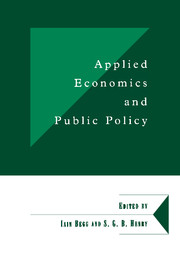Book contents
- Frontmatter
- Contents
- List of figures
- List of tables
- List of contributors
- Foreword
- 1 Introduction
- Part One MODELLING AND FORECASTING METHODS
- 2 Large-scale energy–environment–economy modelling of the European Union
- 3 Measurement errors and data estimation: the quantification of survey data
- 4 Social accounting matrices and applied general equilibrium models
- 5 The development of econometric methods at the DAE
- Part Two COMBINING DATA AND ANALYTIC TECHNIQUES
- Part Three USING MODELS TO GUIDE POLICY
- Bibliography
- Index
2 - Large-scale energy–environment–economy modelling of the European Union
from Part One - MODELLING AND FORECASTING METHODS
Published online by Cambridge University Press: 06 July 2010
- Frontmatter
- Contents
- List of figures
- List of tables
- List of contributors
- Foreword
- 1 Introduction
- Part One MODELLING AND FORECASTING METHODS
- 2 Large-scale energy–environment–economy modelling of the European Union
- 3 Measurement errors and data estimation: the quantification of survey data
- 4 Social accounting matrices and applied general equilibrium models
- 5 The development of econometric methods at the DAE
- Part Two COMBINING DATA AND ANALYTIC TECHNIQUES
- Part Three USING MODELS TO GUIDE POLICY
- Bibliography
- Index
Summary
Introduction
The meteorological experts of the Intergovernmental Panel on Climate, a United Nations body charged with assessing the problem of global warming, have concluded that the atmosphere is heating up and that human activity is responsible (Financial Times, 1 December 1995). If greenhouse gas (GG) emissions go on rising, there will be an increasing risk of catastrophic climate change (Cline, 1992), e.g. an average temperature rise of 6°C over the next 200 years, rising sea levels caused by the melting ice caps, and more extreme events due to the increased latent energy in the atmosphere.
The emissions are an unwanted byproduct of economic activity, such as the burning of fossil fuels for heat, light and power, and the clearing of forests. However, energy can be produced from a variety of sources, some with very low carbon contents, and used in a variety of ways, offering the possibility of even lower levels of emissions. Consumption can also be much less carbon-intensive than at present. In general, there are substantial opportunities for emissions to respond to relative prices (Barker, Ekins and Johnstone (eds), 1995), so that fiscal policy could make a major contribution to reducing emissions, with benefit to the economy and the environment, e.g. through carbon tax revenues being recycled via reductions in employment taxes (Barker, 1995) and by the reduction in fossil fuel use being associated with the reduction in other pollution, such as sulphur dioxide, low-level ozone, noise and dust (Ekins, 1996).
- Type
- Chapter
- Information
- Applied Economics and Public Policy , pp. 15 - 40Publisher: Cambridge University PressPrint publication year: 1998
- 2
- Cited by



